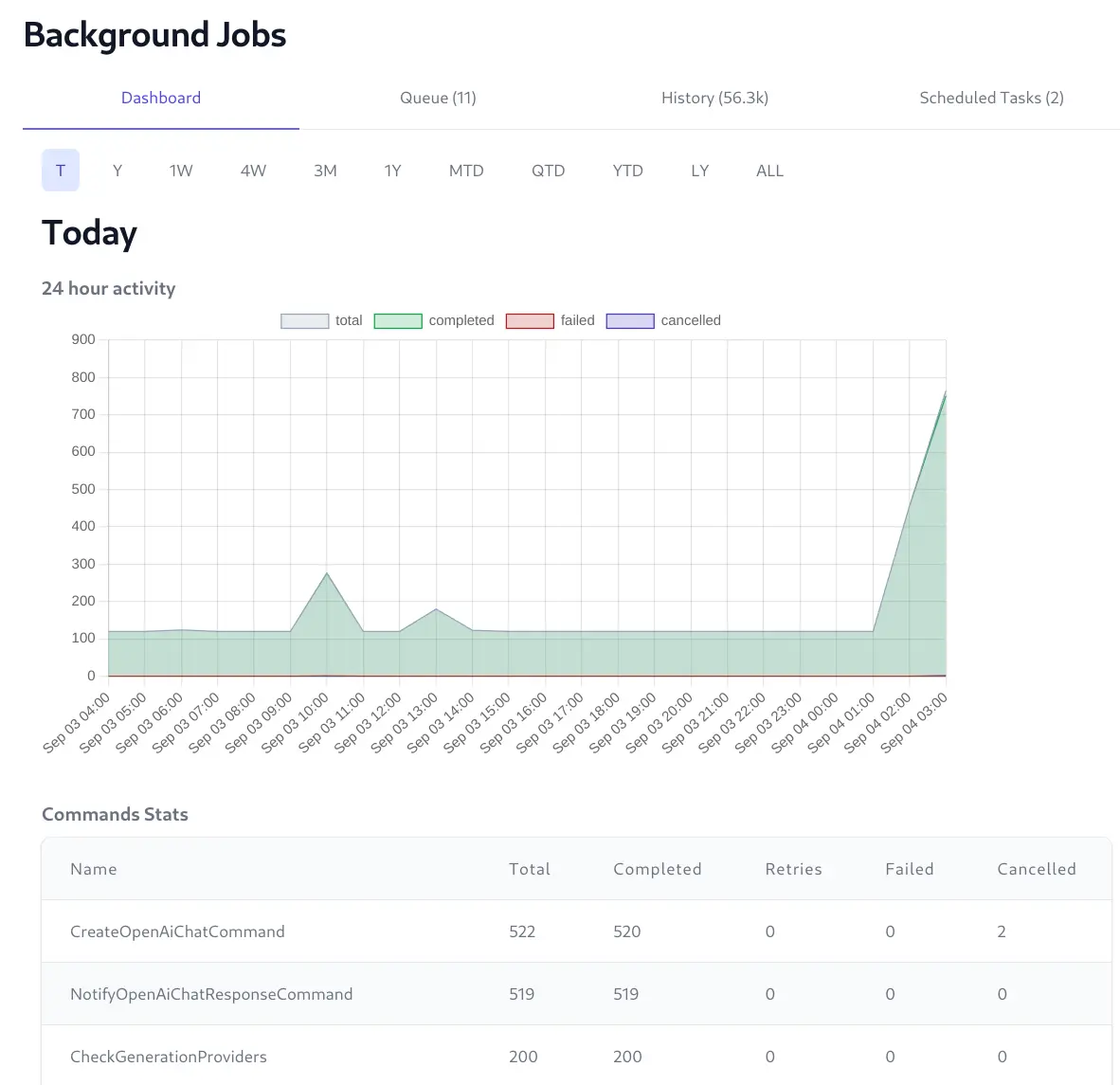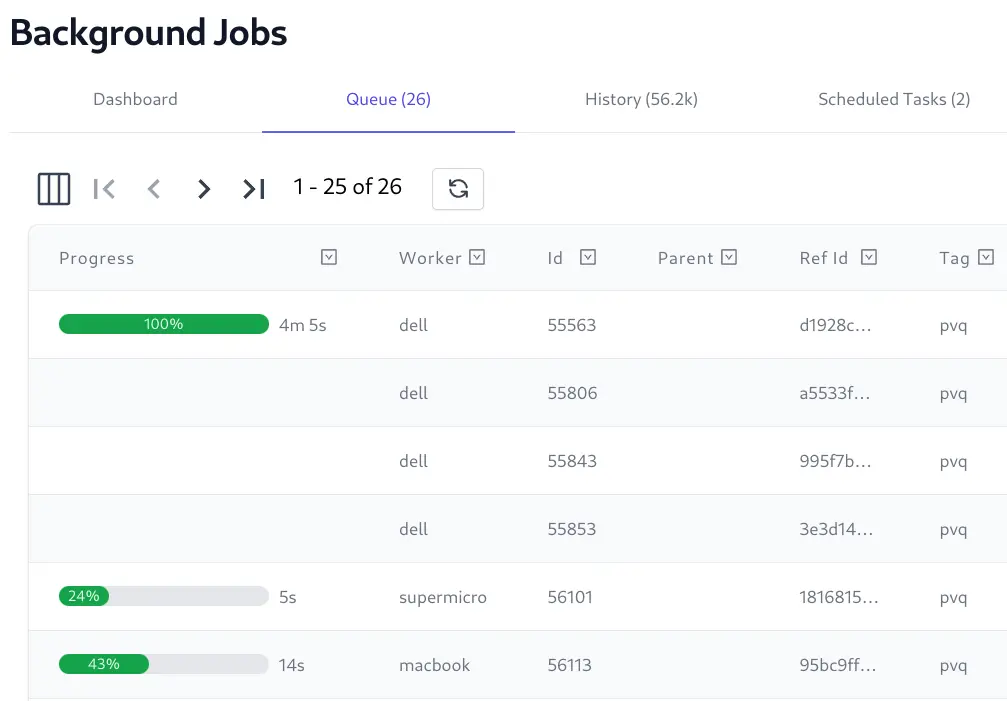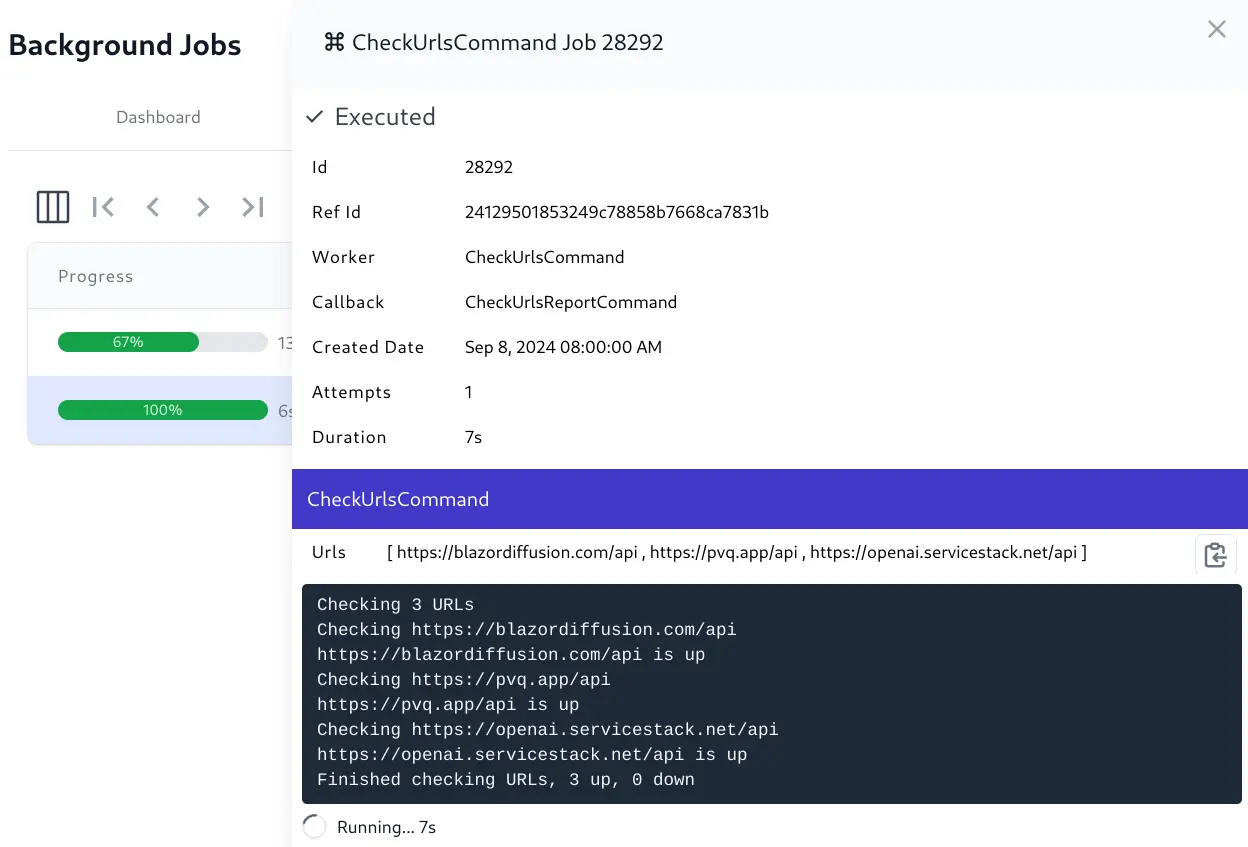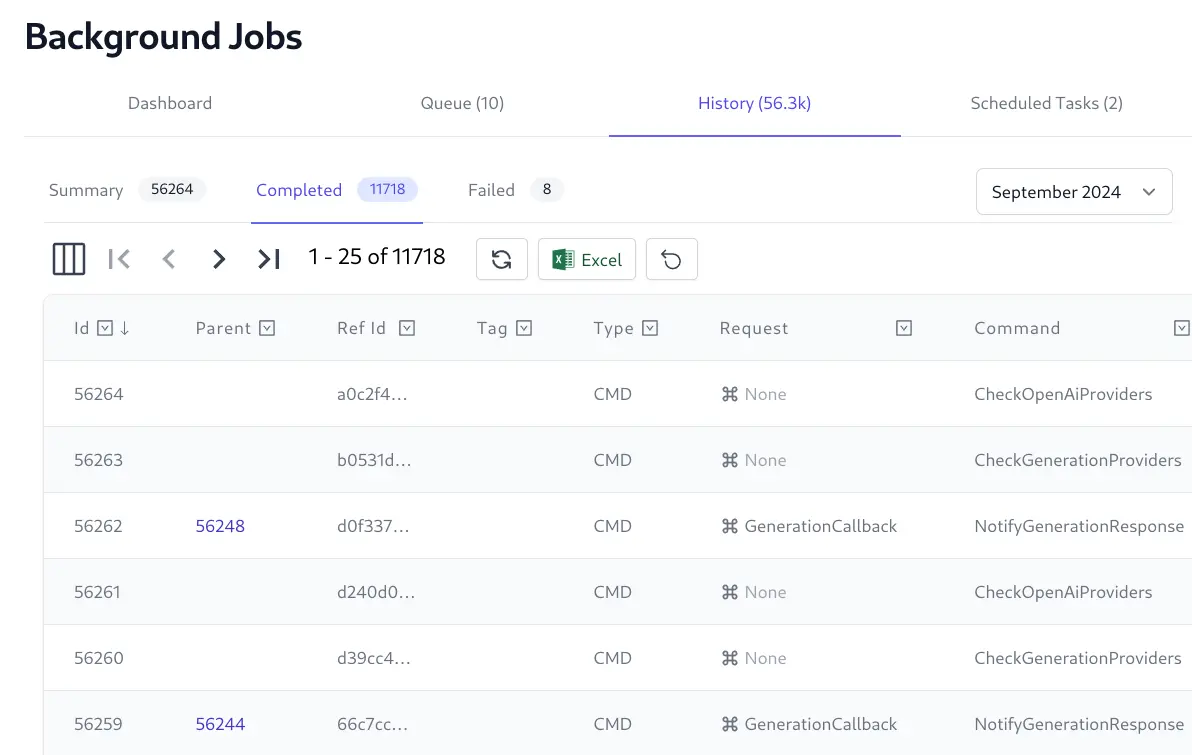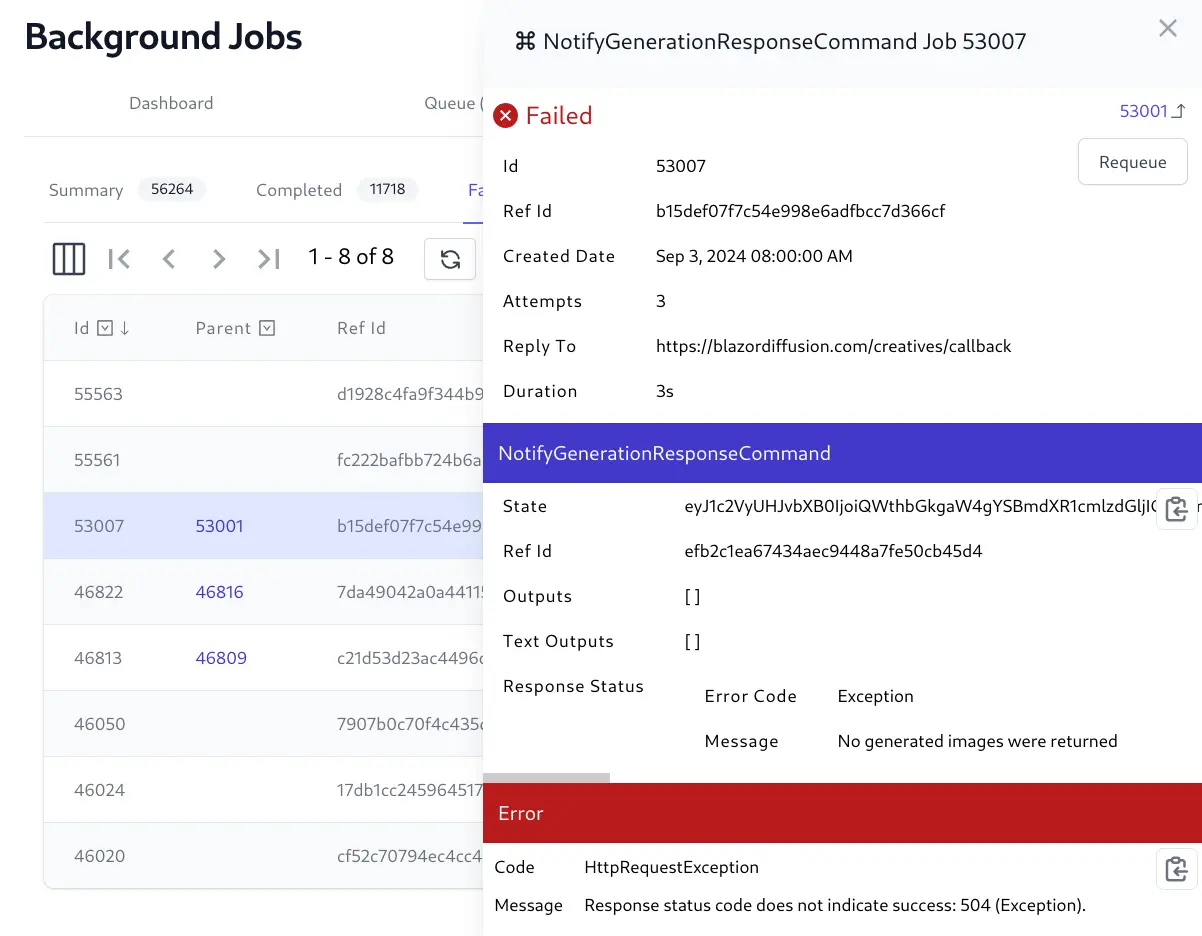The DatabaseJobFeature is a new implementation purpose built for PostgreSQL, SQL Server and MySQL backends that's a drop-in replacement for SQLite's BackgroundsJobFeature which can be applied to an existing .NET 10+ project by mixing in the db-identity or db-jobs gist files to your host project.
Install
For ServiceStack ASP.NET Identity Auth Projects:
npx add-in db-identity
Which replaces Configure.BackgroundJobs.cs and Configure.RequestLogs.cs with an equivalent
version that uses the DatabaseJobFeature for sending Application Emails and DbRequestLogger
for API Request Logging.
All other .NET 10+ ServiceStack Apps should instead use:
npx add-in db-jobs
Which replaces Configure.BackgroundJobs.cs to use DatabaseJobFeature:
public class ConfigureBackgroundJobs : IHostingStartup
{
public void Configure(IWebHostBuilder builder) => builder
.ConfigureServices(services => {
services.AddPlugin(new CommandsFeature());
services.AddPlugin(new DatabaseJobFeature {
// NamedConnection = "<alternative db>"
});
services.AddHostedService<JobsHostedService>();
}).ConfigureAppHost(afterAppHostInit: appHost => {
var services = appHost.GetApplicationServices();
var jobs = services.GetRequiredService<IBackgroundJobs>();
// Example of registering a Recurring Job to run Every Hour
//jobs.RecurringCommand<MyCommand>(Schedule.Hourly);
});
}
public class JobsHostedService(ILogger<JobsHostedService> log, IBackgroundJobs jobs) : BackgroundService
{
protected override async Task ExecuteAsync(CancellationToken stoppingToken)
{
await jobs.StartAsync(stoppingToken);
using var timer = new PeriodicTimer(TimeSpan.FromSeconds(3));
while (!stoppingToken.IsCancellationRequested && await timer.WaitForNextTickAsync(stoppingToken))
{
await jobs.TickAsync();
}
}
}
DatabaseJobFeature reuses the same IBackgroundJobs interface, Data Models, and API Service Contracts
which greatly simplifies any migration efforts from SQLite's ServiceStack.Jobs implementation.
By implementing the same API Service Contracts (i.e. Request/Response DTOs) it's also able to reuse the same built-in Management UI to provide real-time monitoring, inspection and management of background jobs:
RDBMS Optimizations
A key benefit of using SQLite for Background Jobs was the ability to easily maintain completed and failed job history in
separate monthly databases. This approach prevented the main application database from growing unbounded by archiving
historical job data into isolated monthly SQLite database files (e.g., jobs_2025-01.db, jobs_2025-02.db).
These monthly databases could be easily backed up, archived to cold storage, or deleted after a retention period,
providing a simple yet effective data lifecycle management strategy.
For the new DatabaseJobFeature supporting PostgreSQL, SQL Server, and MySQL, we've replicated this monthly
partitioning strategy using monthly partitioned SQL tables for the CompletedJob and FailedJob archive tables.
PostgreSQL - Native Table Partitioning
PostgreSQL provides native support for table partitioning, allowing us to automatically create monthly partitions using
PARTITION BY RANGE on the CreatedDate column. The DatabaseJobFeature automatically creates new monthly partitions
as needed, maintaining the same logical separation as SQLite's monthly .db's while keeping everything within a single
Postgres DB:
CREATE TABLE CompletedJob (
-- columns...
CreatedDate TIMESTAMP NOT NULL,
PRIMARY KEY ("Id","CreatedDate")
) PARTITION BY RANGE ("CreatedDate");
-- Monthly partitions are automatically created, e.g.:
CREATE TABLE CompletedJob_2025_01 PARTITION OF CompletedJob
FOR VALUES FROM ('2025-01-01') TO ('2025-02-01');
This provides excellent query performance since PostgreSQL can use partition pruning to only scan relevant monthly partitions
when filtering by CreatedDate.
SQLServer / MySQL - Manual Partition Management
For SQL Server and MySQL, monthly partitioned tables need to be created out-of-band (either manually or via cronjob scripts) since they don't support the same level of automatic partition management as PostgreSQL. However, this still works well in practice as it uses:
Write-Only Tables - The
CompletedJobandFailedJobtables are write-only append tables. Jobs are never updated after completion or failure, only inserted.CreatedDate Index - All queries against these tables use the
CreatedDateindexed column for filtering and sorting, ensuring efficient access patterns even as the tables grow.
The indexed CreatedDate column ensures that queries remain performant regardless of table size, and the write-only
nature means there's no complex update logic to manage across partitions.
This approach maintains the same benefits as SQLite's monthly databases - easy archival, manageable table sizes, and efficient queries - while leveraging the scalability and features of enterprise RDBMS systems.
Separate Jobs Database
Or if preferred, you can maintain background jobs in a separate database from your main application database. This separation keeps the write-heavy job processing load off your primary database, allowing you to optimize each database independently for its specific workload patterns like maintaining different backup strategies for your critical application data vs. job history.
// Configure.Db.cs
services.AddOrmLite(options => options.UsePostgres(connectionString))
.AddPostgres("jobs", jobsConnectionString);
// Configure.BackgroundJobs.cs
services.AddPlugin(new DatabaseJobFeature {
NamedConnection = "jobs"
});
Real Time Admin UI
The Jobs Admin UI provides a real time view into the status of all background jobs including their progress, completion times, Executed, Failed, and Cancelled Jobs, etc. which is useful for monitoring and debugging purposes.
View Real-time progress of queued Jobs
View real-time progress logs of executing Jobs
View Job Summary and Monthly Databases of Completed and Failed Jobs
View full state and execution history of each Job
Cancel Running jobs and Requeue failed jobs
Usage
For even greater reuse of your APIs you're able to queue your existing ServiceStack Request DTOs as a Background Job in addition to Commands for encapsulating units of logic into internal invokable, inspectable and auto-retryable building blocks.
Queue Commands
Any API, Controller or Minimal API can execute jobs with the IBackgroundJobs dependency, e.g.
here's how you can run a background job to send a new email when an API is called in
any new Identity Auth template:
class MyService(IBackgroundJobs jobs) : Service
{
public object Any(MyOrder request)
{
var jobRef = jobs.EnqueueCommand<SendEmailCommand>(new SendEmail {
To = "my@email.com",
Subject = $"Received New Order {request.Id}",
BodyText = $"""
Order Details:
{request.OrderDetails.DumptTable()}
""",
});
//...
}
}
Which records and immediately executes a worker to execute the SendEmailCommand with the specified
SendEmail Request argument. It also returns a reference to a Job which can be used later to query
and track the execution of a job.
Queue APIs
Alternatively a SendEmail API could be executed with just the Request DTO:
var jobRef = jobs.EnqueueApi(new SendEmail {
To = "my@email.com",
Subject = $"Received New Order {request.Id}",
BodyText = $"""
Order Details:
{request.OrderDetails.DumptTable()}
""",
});
Although Sending Emails is typically not an API you want to make externally available and would want to Restrict access or limit usage to specified users.
In both cases the SendEmail Request is persisted into the Jobs SQLite database for durability
that gets updated as it progresses through the queue.
For execution the API or command is resolved from the IOC before being invoked with the Request. APIs are executed via the MQ Request Pipeline and commands executed using the Commands Feature where they'll also be visible in the Commands Admin UI.
Feature Overview
It packs most features needed in a Background Jobs solution including:
- Use your App's existing RDBMS (no other infrastructure dependencies)
- Execute existing APIs or versatile Commands
- Commands auto registered in IOC
- Scheduled Reoccurring Tasks
- Track Last Job Run
- Serially execute jobs with the same named Worker
- Queue Jobs dependent on successful completion of parent Job
- Queue Jobs to be executed after a specified Date
- Execute Jobs within the context of an Authenticated User
- Auto retry failed jobs on a default or per-job limit
- Timeout Jobs on a default or per-job limit
- Cancellable Jobs
- Requeue Failed Jobs
- Execute custom callbacks on successful execution of Job
- Maintain Status, Logs, and Progress of Executing Jobs
- Execute transitive (i.e. non-durable) jobs using named workers
- Attach optional
Tag,BatchId,CreatedBy,ReplyToandArgswith Jobs
Background Job Options
The behavior for each Enqueue* method for executing background jobs can be customized with
the following options:
Worker- Serially process job using a named worker threadCallback- Invoke another command with the result of a successful jobDependsOn- Execute jobs after successful completion of a dependent job- If parent job fails all dependent jobs are cancelled
UserId- Execute within an Authenticated User ContextRunAfter- Queue jobs that are only run after a specified dateRetryLimit- Override default retry limit for how many attempts should be made to execute a jobTimeoutSecs- Override default timeout for how long a job should run before being cancelledRefId- Allow clients to specify a unique Id (e.g Guid) to track jobTag- Group related jobs under a user specified tagCreatedBy- Optional field for capturing the owner of a jobBatchId- Group multiple jobs with the same IdReplyTo- Optional field for capturing where to send notification for completion of a JobArgs- Optional String Dictionary of Arguments that can be attached to a Job
Executing non-durable jobs
IBackgroundJobs also supports RunCommand methods to be able to execute jobs transiently
(i.e. non-durable), which is useful for commands that want to be serially executed by a named worker
but don't need to be persisted.
You could use this to queue system emails to be sent by the same smtp worker and are happy to avoid tracking its state and execution history in the Jobs database.
var job = jobs.RunCommand<SendEmailCommand>(new SendEmail { ... },
new() {
Worker = "smtp"
});
In this case RunCommand returns the actual BackgroundJob instance that will be updated by
the worker.
You can also use RunCommandAsync if you prefer to wait until the job has been executed. Instead
of a Job it returns the Result of the command if it returned one.
var result = await jobs.RunCommandAsync<SendEmailCommand>(new SendEmail {...},
new() {
Worker = "smtp"
});
Serially Execute Jobs with named Workers
By default jobs are executed immediately in a new Task, we can also change the behavior to instead execute jobs one-by-one in a serial queue by specifying them to use the same named worker as seen in the example above.
Alternatively you can annotate the command with the [Worker] attribute if you always want
all jobs executing the command to use the same worker:
[Worker("smtp")]
public class SendEmailCommand(IBackgroundJobs jobs) : SyncCommand<SendEmail>
{
//...
}
Use Callbacks to process the results of Commands
Callbacks can be used to extend the lifetime of a job to include processing a callback to process its results. This is useful where you would like to reuse the the same command but handle the results differently, e.g. the same command can email results or invoke a webhook by using a callback:
jobs.EnqueueCommand<CheckUrlsCommand>(new CheckUrls { Urls = allUrls },
new() {
Callback = nameof(EmailUrlResultsCommand),
});
jobs.EnqueueCommand<CheckUrlsCommand>(new CheckUrls { Urls = criticalUrls },
new() {
Callback = nameof(WebhookUrlResultsCommand),
ReplyTo = callbackUrl
});
Callbacks that fail are auto-retried the same number of times as their jobs, which if they all fail then the entire job is also marked as failed.
Run Job dependent on successful completion of parent
Jobs can be queued to only run after the successful completion of another job, this is useful for when you need to kick off multiple jobs after a long running task has finished like generating monthly reports after monthly data has been aggregated, e.g:
var jobRef = jobs.EnqueueCommand<AggregateMonthlyDataCommand>(new Aggregate {
Month = DateTime.UtcNow
});
jobs.EnqueueCommand<GenerateSalesReportCommand>(new () {
DependsOn = jobRef.Id,
});
jobs.EnqueueCommand<GenerateExpenseReportCommand>(new () {
DependsOn = jobRef.Id,
});
Inside your command you can get a reference to your current job with Request.GetBackgroundJob()
which will have its ParentId populated with the parent job Id and job.ParentJob containing
a reference to the completed Parent Job where you can access its Request, Results and other job
information:
public class GenerateSalesReportCommand(ILogger<MyCommandNoArgs> log)
: SyncCommand
{
protected override void Run()
{
var job = Request.GetBackgroundJob();
var parentJob = job.ParentJob;
}
}
Atomic Batching Behavior
We can also use DependsOn to implement atomic batching behavior where from inside our
executing command we can queue new jobs that are dependent on the successful execution
of the current job, e.g:
public class CheckUrlsCommand(IHttpClientFactory factory, IBackgroundJobs jobs)
: AsyncCommand<CheckUrls>
{
protected override async Task RunAsync(CheckUrls req, CancellationToken ct)
{
var job = Request.GetBackgroundJob();
var batchId = Guid.NewGuid().ToString("N");
using var client = factory.CreateClient();
foreach (var url in req.Urls)
{
var msg = new HttpRequestMessage(HttpMethod.Get, url);
var response = await client.SendAsync(msg, ct);
response.EnsureSuccessStatusCode();
jobs.EnqueueCommand<SendEmailCommand>(new SendEmail {
To = "my@email.com",
Subject = $"{new Uri(url).Host} status",
BodyText = $"{url} is up",
}, new() {
DependsOn = job.Id,
BatchId = batchId,
});
}
}
}
Where any dependent jobs are only executed if the job was successfully completed. If instead an exception was thrown during execution, the job will be failed and all its dependent jobs cancelled and removed from the queue.
Executing jobs with an Authorized User Context
If you have logic dependent on an Authenticated ClaimsPrincipal or ServiceStack
IAuthSession you can have your APIs and Commands also be executed with that user context
by specifying the UserId the job should be executed as:
var openAiRequest = new CreateOpenAiChat {
Request = new() {
Model = "gpt-4",
Messages = [
new() {
Content = request.Question
}
]
},
};
// Example executing API Job with User Context
jobs.EnqueueApi(openAiRequest,
new() {
UserId = Request.GetClaimsPrincipal().GetUserId(),
CreatedBy = Request.GetClaimsPrincipal().GetUserName(),
});
// Example executing Command Job with User Context
jobs.EnqueueCommand<CreateOpenAiChatCommand>(openAiRequest,
new() {
UserId = Request.GetClaimsPrincipal().GetUserId(),
CreatedBy = Request.GetClaimsPrincipal().GetUserName(),
});
Inside your API or Command you access the populated User ClaimsPrincipal or
ServiceStack IAuthSession using the same APIs that you'd use inside your ServiceStack APIs, e.g:
public class CreateOpenAiChatCommand(IBackgroundJobs jobs)
: AsyncCommand<CreateOpenAiChat>
{
protected override async Task RunAsync(
CreateOpenAiChat request, CancellationToken token)
{
var user = Request.GetClaimsPrincipal();
var session = Request.GetSession();
//...
}
}
Queue Job to run after a specified date
Using RunAfter lets you queue jobs that are only executed after a specified DateTime,
useful for executing resource intensive tasks at low traffic times, e.g:
var jobRef = jobs.EnqueueCommand<AggregateMonthlyDataCommand>(new Aggregate {
Month = DateTime.UtcNow
},
new() {
RunAfter = DateTime.UtcNow.Date.AddDays(1)
});
Attach Metadata to Jobs
All above Background Job Options have an effect on when and how Jobs are executed. There are also a number of properties that can be attached to a Job that can be useful in background job processing despite not having any effect on how jobs are executed.
These properties can be accessed by commands or APIs executing the Job and are visible and can be filtered in the Jobs Admin UI to help find and analyze executed jobs.
var jobRef = jobs.EnqueueCommand<CreateOpenAiChatCommand>(openAiRequest,
new() {
// Group related jobs under a common tag
Tag = "ai",
// A User-specified or system generated unique Id to track the job
RefId = request.RefId,
// Capture who created the job
CreatedBy = Request.GetClaimsPrincipal().GetUserName(),
// Link jobs together that are sent together in a batch
BatchId = batchId,
// Capture where to notify the completion of the job to
ReplyTo = "https:example.org/callback",
// Additional properties about the job that aren't in the Request
Args = new() {
["Additional"] = "Metadata"
}
});
Querying a Job
A job can be queried by either it's auto-incrementing Id Primary Key or by a unique RefId
that can be user-specified.
var jobResult = jobs.GetJob(jobRef.Id);
var jobResult = jobs.GetJobByRefId(jobRef.RefId);
At a minimum a JobResult will contain the Summary Information about a Job as well as the
full information about a job depending on where it's located:
class JobResult
{
// Summary Metadata about a Job in the JobSummary Table
JobSummary Summary
// Job that's still in the BackgroundJob Queue
BackgroundJob? Queued
// Full Job information in Monthly DB CompletedJob Table
CompletedJob? Completed
// Full Job information in Monthly DB FailedJob Table
FailedJob? Failed
// Helper to access full Job Information
BackgroundJobBase? Job => Queued ?? Completed ?? Failed
}
Job Execution Limits
Default Retry and Timeout Limits can be configured on the Backgrounds Job plugin:
services.AddPlugin(new BackgroundsJobFeature
{
DefaultRetryLimit = 2,
DefaultTimeout = TimeSpan.FromMinutes(10),
});
These limits are also overridable on a per-job basis, e.g:
var jobRef = jobs.EnqueueCommand<AggregateMonthlyDataCommand>(new Aggregate {
Month = DateTime.UtcNow
},
new() {
RetryLimit = 3,
Timeout = TimeSpan.FromMinutes(30),
});
Logging, Cancellation an Status Updates
We'll use the command for checking multiple URLs to demonstrate some recommended patterns and how to enlist different job processing features.
public class CheckUrlsCommand(
ILogger<CheckUrlsCommand> logger,
IBackgroundJobs jobs,
IHttpClientFactory clientFactory) : AsyncCommand<CheckUrls>
{
protected override async Task RunAsync(CheckUrls req, CancellationToken ct)
{
// 1. Create Logger that Logs and maintains logging in Jobs DB
var log = Request.CreateJobLogger(jobs,logger);
// 2. Get Current Executing Job
var job = Request.GetBackgroundJob();
var result = new CheckUrlsResult {
Statuses = new()
};
using var client = clientFactory.CreateClient();
for (var i = 0; i < req.Urls.Count; i++)
{
// 3. Stop processing Job if it's been cancelled
ct.ThrowIfCancellationRequested();
var url = req.Urls[i];
try
{
var msg = new HttpRequestMessage(HttpMethod.Get,url);
var response = await client.SendAsync(msg, ct);
result.Statuses[url] = response.IsSuccessStatusCode;
log.LogInformation("{Url} is {Status}",
url, response.IsSuccessStatusCode ? "up" : "down");
// 4. Optional: Maintain explicit progress and status updates
log.UpdateStatus(i/(double)req.Urls.Count,$"Checked {i} URLs");
}
catch (Exception e)
{
log.LogError(e, "Error checking {Url}", url);
result.Statuses[url] = false;
}
}
// 5. Send Results to WebHook Callback if specified
if (job.ReplyTo != null)
{
jobs.EnqueueCommand<NotifyCheckUrlsCommand>(result,
new() {
ParentId = job.Id,
ReplyTo = job.ReplyTo,
});
}
}
}
We'll cover some of the notable parts useful when executing Jobs:
1. Job Logger
We can use a Job logger to enable database logging that can be monitored in real-time in the
Admin Jobs UI. Creating it with both BackgroundJobs and ILogger will return a combined
logger that both Logs to standard output and to the Jobs database:
var log = Request.CreateJobLogger(jobs,logger);
Or just use Request.CreateJobLogger(jobs) to only save logs to the database.
2. Resolve Executing Job
If needed the currently executing job can be accessed with:
var job = Request.GetBackgroundJob();
Where you'll be able to access all the metadata the jobs were created with including ReplyTo
and Args.
3. Check if Job has been cancelled
To be able to cancel a long running job you'll need to periodically check if a Cancellation
has been requested and throw a TaskCanceledException if it has to short-circuit the command
which can be done with:
ct.ThrowIfCancellationRequested();
You'll typically want to call this at the start of any loops to prevent it from doing any more work.
4. Optionally record progress and status updates
By default Background Jobs looks at the last API or Command run and worker used to estimate the duration and progress for how long a running job will take.
If preferred your command can explicitly set a more precise progress and optional status update that should be used instead, e.g:
log.UpdateStatus(progress:i/(double)req.Urls.Count, $"Checked {i} URLs");
Although generally the estimated duration and live logs provide a good indication for the progress of a job.
5. Notify completion of Job
Calling a Web Hook is a good way to notify externally initiated job requests of the completion of a job. You could invoke the callback within the command itself but there are a few benefits to initiating another job to handle the callback:
- Frees up the named worker immediately to process the next task
- Callbacks are durable, auto-retried and their success recorded like any job
- If a callback fails the entire command doesn't need to be re-run again
We can queue a callback with the result by passing through the ReplyTo and link it to the
existing job with:
if (job.ReplyTo != null)
{
jobs.EnqueueCommand<NotifyCheckUrlsCommand>(result,
new() {
ParentId = job.Id,
ReplyTo = job.ReplyTo,
});
}
Which we can implement by calling the SendJsonCallbackAsync extension method with the
Callback URL and the Result DTO it should be called with:
public class NotifyCheckUrlsCommand(IHttpClientFactory clientFactory)
: AsyncCommand<CheckUrlsResult>
{
protected override async Task RunAsync(
CheckUrlsResult request, CancellationToken token)
{
await clientFactory.SendJsonCallbackAsync(
Request.GetBackgroundJob().ReplyTo, request, token);
}
}
Callback URLs
ReplyTo can be any URL which by default will have the result POST'ed back to the URL with a JSON
Content-Type. Typically URLs will contain a reference Id so external clients can correlate a callback
with the internal process that initiated the job. If the callback API is publicly available you'll
want to use an internal Id that can't be guessed (like a Guid) so the callback can't be spoofed, e.g:
$"https://api.example.com/callback?refId={RefId}"
If needed the callback URL can be customized on how the HTTP Request callback is sent.
If the URL contains a space, the text before the space is treated as the HTTP method:
"PUT https://api.example.com/callback"
If the auth part contains a colon : it's treated as Basic Auth:
"username:password@https://api.example.com/callback"
If name starts with http. sends a HTTP Header
"http.X-API-Key:myApiKey@https://api.example.com/callback"
Otherwise it's sent as a Bearer Token:
"myToken123@https://api.example.com/callback"
Bearer Token or HTTP Headers starting with $ is substituted with Environment Variable if exists:
"$API_TOKEN@https://api.example.com/callback"
When needed headers, passwords and tokens can be URL encoded if they contain any delimiter characters.
Implementing Commands
At a minimum a command need only implement the simple IAsyncCommand interface:
public interface IAsyncCommand<in T>
{
Task ExecuteAsync(T request);
}
Which is the singular interface that can execute any command.
However commands executed via Background Jobs have additional context your commands may need to
access during execution, including the BackgroundJob itself, the CancellationToken and
an Authenticated User Context.
To reduce the effort in creating commands with a IRequest context we've added a number ergonomic
base classes to better capture the different call-styles a unit of logic can have including
Sync or Async execution, whether they require Input Arguments or have Result Outputs.
Choosing the appropriate Abstract base class benefits from IDE tooling in generating the method signature that needs to be implemented whilst Async commands with Cancellation Tokens in its method signature highlights any missing async methods that are called without the token.
Sync Commands
SyncCommand- Requires No ArgumentsSyncCommand<TRequest>- Requires TRequest ArgumentSyncCommandWithResult<TResult>- Requires No Args and returns ResultSyncCommandWithResult<TRequest,TResult>- Requires Argument and returns Result
public record MyArgs(int Id);
public record MyResult(string Message);
public class MyCommandNoArgs(ILogger<MyCommandNoArgs> log) : SyncCommand
{
protected override void Run()
{
log.LogInformation("Called with No Args");
}
}
public class MyCommandArgs(ILogger<MyCommandNoArgs> log) : SyncCommand<MyArgs>
{
protected override void Run(MyArgs request)
{
log.LogInformation("Called with {Id}", request.Id);
}
}
public class MyCommandWithResult(ILogger<MyCommandNoArgs> log) : SyncCommandWithResult<MyResult>
{
protected override MyResult Run()
{
log.LogInformation("Called with No Args and returns Result");
return new MyResult("Hello World");
}
}
public class MyCommandWithArgsAndResult(ILogger<MyCommandNoArgs> log)
: SyncCommandWithResult<MyArgs,MyResult>
{
protected override MyResult Run(MyArgs request)
{
log.LogInformation("Called with {Id} and returns Result", request.Id);
return new MyResult("Hello World");
}
}
Async Commands
AsyncCommand- Requires No ArgumentsAsyncCommand<TRequest>- Requires TRequest ArgumentAsyncCommandWithResult<TResult>- Requires No Args and returns ResultAsyncCommandWithResult<TReq,TResult>- Requires Argument and returns Result
public class MyAsyncCommandNoArgs(ILogger<MyCommandNoArgs> log) : AsyncCommand
{
protected override async Task RunAsync(CancellationToken token)
{
log.LogInformation("Async called with No Args");
}
}
public class MyAsyncCommandArgs(ILogger<MyCommandNoArgs> log)
: AsyncCommand<MyArgs>
{
protected override async Task RunAsync(MyArgs request, CancellationToken token)
{
log.LogInformation("Async called with {Id}", request.Id);
}
}
public class MyAsyncCommandWithResult(ILogger<MyCommandNoArgs> log)
: AsyncCommandWithResult<MyResult>
{
protected override async Task<MyResult> RunAsync(CancellationToken token)
{
log.LogInformation("Async called with No Args and returns Result");
return new MyResult("Hello World");
}
}
public class MyAsyncCommandWithArgsAndResult(ILogger<MyCommandNoArgs> log)
: AsyncCommandWithResult<MyArgs,MyResult>
{
protected override async Task<MyResult> RunAsync(
MyArgs request, CancellationToken token)
{
log.LogInformation("Called with {Id} and returns Result", request.Id);
return new MyResult("Hello World");
}
}
